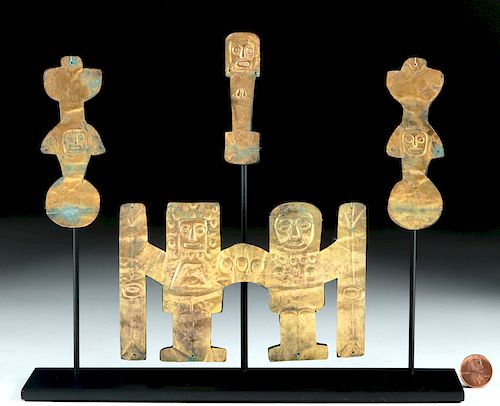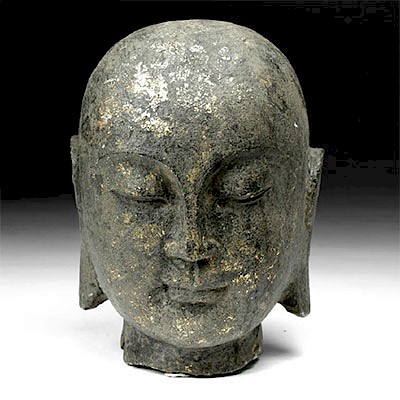Superb Tiahuanaco Gilded Copper Applique Ensemble
Lot 168
About Seller
Artemis Fine Arts
686 S Taylor Ave, Ste 106
Louisville, CO 80027
United States
Selling antiquities, ancient and ethnographic art online since 1993, Artemis Gallery specializes in Classical Antiquities (Egyptian, Greek, Roman, Near Eastern), Asian, Pre-Columbian, African / Tribal / Oceanographic art. Our extensive inventory includes pottery, stone, metal, wood, glass and textil...Read more
Estimate:
$10,000 - $15,000
Absentee vs Live bid
Two ways to bid:
- Leave a max absentee bid and the platform will bid on your behalf up to your maximum bid during the live auction.
- Bid live during the auction and your bids will be submitted real-time to the auctioneer.
Bid Increments
| Price | Bid Increment |
|---|---|
| $0 | $25 |
| $300 | $50 |
| $1,000 | $100 |
| $2,000 | $250 |
| $5,000 | $500 |
| $10,000 | $1,000 |
| $20,000 | $2,500 |
| $50,000 | $5,000 |
| $100,000 | $10,000 |
| $200,000 | $20,000 |
About Auction
By Artemis Fine Arts
Nov 29, 2018
Set Reminder
2018-11-29 10:00:00
2018-11-29 10:00:00
America/New_York
Bidsquare
Bidsquare : Holiday Glitz - Ancient / Ethnographic Art
https://www.bidsquare.com/auctions/artemis-gallery/holiday-glitz---ancient-ethnographic-art-3672
What to give this holiday season? Think silver, gold, bronze, shiny, glittery, wearable, festive. We ship worldwide and handle all shipping in-house for your convenience. This is one sale you don't want to miss! Artemis Fine Arts info@artemisgallery.com
What to give this holiday season? Think silver, gold, bronze, shiny, glittery, wearable, festive. We ship worldwide and handle all shipping in-house for your convenience. This is one sale you don't want to miss! Artemis Fine Arts info@artemisgallery.com
- Lot Description
Pre-Columbian, Bolivia, Lake Titicaca region, Tiahuanaco / Tiwanaku, ca. 400 to 700 CE. A beautiful set of hammered copper appliques covered in gilding in a variety of abstract anthropomorphic forms. A pair of simplistic faces hover in the middle of strange winged forms with globular bodies and cupped cranial extensions, and a spade-shaped body bears a third face with mouth agape and holding a pair of minimalistic arms to its chest. The largest element is comprised of two figures standing, their interior arms meeting and each exterior holding a thin staff. The leftmost figure is a depiction of Paccha Mama, the goddess of the earth exalted by many ancient and modern native Andean peoples. Her radiating coronal crown and rectangular head make her stylized presentation one of great reverence and fear among the ancient Tiahuanaco peoples, for it was believed not sating her will to collect upon sacrifices and offerings would bring about great devastation upon the lands. Custom museum-quality display stand included. Size of largest: 5.3" W x 3.5" H (13.5 cm x 8.9 cm).
The monumental city of Tihuanaco / Tiwanaku in the Bolivian highlands is an incredible 13,000 feet above sea level. Among the 754 recognized World Heritage Sites, Tiwanaku is surrounded by glorious mountain ranges, with Lake Titicaca on the west border. Huge blocks of a stone which are not actually indigenous to the otherwise flat plateau have inspired Tiwanaku's nickname - "the Stonehenge of the Americas".
The Tiahuanaco peoples were infatuated with gold and silver. Many elements of high-society life revolved around the glint of yellow gold or the blinding reflection of silver, so much so that those comprising the upper class were oftentimes buried wearing full, elaborate vestments adorned with dozens if not hundreds of small gold appliques (Young-Sanchez, Margaret. Tiwanaku: Ancestors of the Inca. University of Nebraska Press, Denver Art Museum, 2004, pp. 59-60). Images of anthropomorphic figures, animals, and even masks have been discovered in archaeological sites, particularly in that Palace of the Multi-Colored Rooms which some archaeologists have deemed as one of "the richest Tiwanaku burials known to date" (Eeckhout, Peter, and Lawrence S. Owens. Funerary Practices and Models in the Ancient Andes: the Return of the Living Dead. Cambridge University Press, 2015, p. 151).
Provenance: private Hawaii, USA collection; ex-private Morris collection, New Mexico, USA
All items legal to buy/sell under U.S. Statute covering cultural patrimony Code 2600, CHAPTER 14, and are guaranteed to be as described or your money back.
A Certificate of Authenticity will accompany all winning bids.
We ship worldwide and handle all shipping in-house for your convenience.
#136579Each item has surface wear and light abrasions commensurate with age as expected, light tarnishing to gilded surfaces and some blue-green patina, slight bending to overall form, and some fading to low-relief details. Each element suspended to stand with thin elastic bands.Condition
- Shipping Info
-
All shipping is handled in-house for your convenience. Your invoice from Artemis Gallery will include shipping calculation instructions. If in doubt, please inquire BEFORE bidding for estimated shipping costs for individual items.
-
- Buyer's Premium



 EUR
EUR CAD
CAD AUD
AUD GBP
GBP MXN
MXN HKD
HKD CNY
CNY MYR
MYR SEK
SEK SGD
SGD CHF
CHF THB
THB















